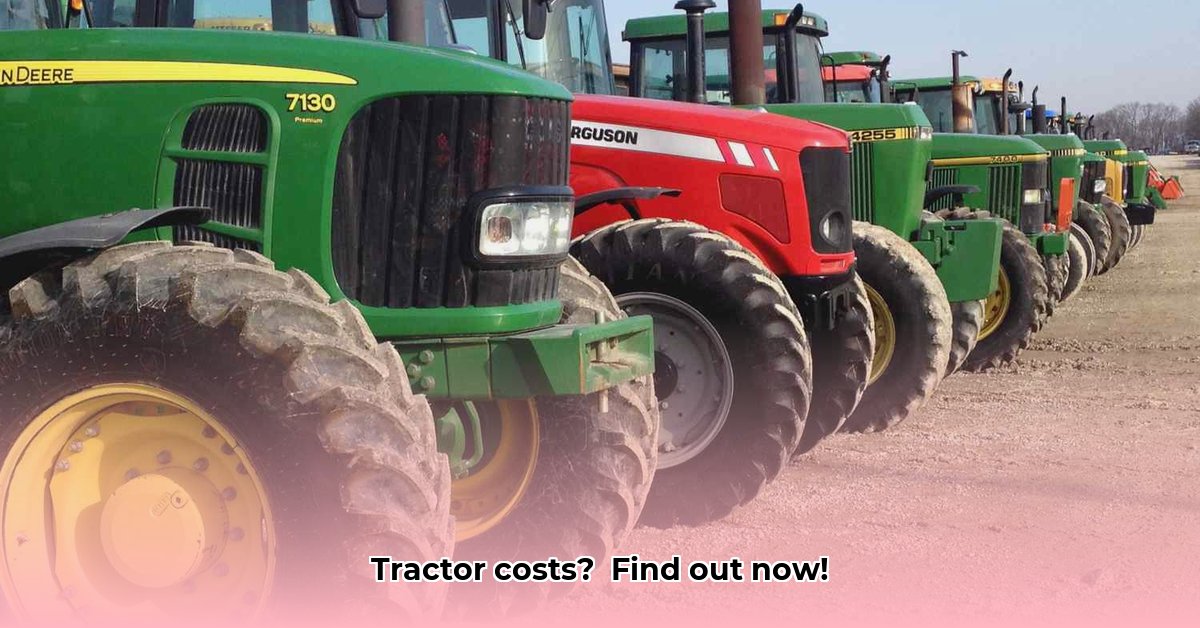
Buying a farm tractor is a significant investment. This guide provides a comprehensive understanding of the costs involved, factors influencing price, and strategies for sustainable farming practices. We'll explore new versus used tractors, financing options, and maintenance to help you make informed decisions. For more detailed pricing information, see this helpful resource on tractor pricing.
Factors Affecting Tractor Cost
The cost of a farm tractor varies greatly. Several key factors determine the final price:
- Horsepower (HP): Higher horsepower equates to greater power and capabilities, resulting in a higher price. Think of it like car engines; more power means a higher cost.
- Brand: Established brands known for their quality and technology typically command higher prices than lesser-known brands.
- Age: New tractors are significantly more expensive than used tractors. The condition of the used tractor will greatly impact the price.
- Features: Advanced features such as GPS guidance, automatic steering, and specialized attachments increase the overall cost.
- Attachments: Additional equipment like loaders, tillers, and mowers significantly impact the total expense.
These factors interact to create a broad price range. A smaller, used tractor might cost tens of thousands of dollars, while a large, new tractor with advanced features could easily exceed hundreds of thousands.
New vs. Used Tractors: A Sustainability Analysis
The decision between a new and used tractor involves more than just the initial cost. This decision significantly impacts both your bottom line and your environmental footprint.
New Tractors:
- Pros: Generally more fuel-efficient, reliable, and technologically advanced (often incorporating sustainability features). Often come with warranties.
- Cons: Significantly higher initial cost. Higher manufacturing emissions up front.
Used Tractors:
- Pros: Lower initial cost, making them accessible to farmers with smaller budgets.
- Cons: Potentially higher maintenance and repair costs, lower fuel efficiency, and increased risk of breakdowns. The environmental impact may be lower initially, but potential future fuel consumption and shorter lifespan might offset this.
The best choice depends on your budget, risk tolerance, and long-term sustainability goals. A thorough cost-benefit analysis, weighing initial investment against long-term running costs, is crucial.
Financing Options: Securing Your Investment
Financing options play a pivotal role in tractor acquisition. Two primary avenues exist: loans and leases.
- Loans: Allow you to own the tractor outright after repayment but require regular payments over an extended period. Interest rates and loan terms vary greatly depending on your creditworthiness and the lender.
- Leases: Involve periodic payments for using the tractor over a specific term. At the lease's end, you may return the tractor or have the option to purchase it. Leasing may alleviate upfront costs but limits long-term cost savings.
Small-scale farmers may find leasing more manageable, while larger farms might prefer the ownership security offered by loans. Thoroughly investigate available financing options and compare terms to ensure a financially responsible decision.
Choosing the Right Tractor: A Step-by-Step Guide
Selecting the appropriate tractor involves a systematic approach:
- Assess your needs: Determine the specific tasks the tractor will perform and the acreage you need to cover. This dictates the required horsepower and features.
- Set a realistic budget: Establish a clear budget, factoring in both the initial purchase price and ongoing expenses.
- Research and compare models: Investigate various brands and models, comparing specifications such as fuel efficiency, horsepower, and available features. Prioritize fuel-efficient models for enhanced sustainability.
- Conduct a thorough inspection (used tractors): For used tractors, a pre-purchase inspection by a qualified mechanic is essential to avoid costly repairs later.
- Secure financing: Once you've chosen a tractor, seek out suitable financing options, comparing interest rates and repayment terms.
Ongoing Tractor Costs: Beyond the Purchase Price
The initial cost represents only a portion of the total expense. Ongoing costs include:
- Fuel: Fuel consumption varies considerably depending on the tractor's age, size, and operating conditions. Fuel efficiency is paramount for both economic and environmental sustainability.
- Maintenance: Regular maintenance, including oil changes, filter replacements, and other preventative measures, is crucial for extending the tractor's lifespan and preventing costly repairs.
- Repairs: Unexpected repairs are inevitable, and their cost can vary widely.
- Insurance: Protect your investment with appropriate insurance coverage.
- Attachments: The cost of additional equipment, such as loaders or tillers, adds to the overall expense.
Sustainability Considerations in Tractor Ownership
Sustainable farming practices necessitate efficient resource utilization. Here are crucial considerations:
- Fuel Efficiency: Prioritize tractors with proven fuel efficiency to minimize operating expenses and reduce your environmental footprint.
- Precision Agriculture: Explore the use of GPS-guided tractors and other precision agriculture technology to optimize resource use and reduce waste.
- Responsible Disposal: Follow proper disposal procedures for old or unusable tractors to mitigate environmental hazards.
Resources and Further Reading
[Link to relevant governmental agricultural resources and websites] (This section would need to be populated with actual links)
This guide provides a framework for making informed decisions regarding farm tractor purchases. Careful planning, consideration of long-term costs, and a commitment to sustainable practices are essential for achieving both economic success and environmental responsibility. Remember, the right tractor is a significant investment, impacting your farm's productivity and environmental stewardship for years to come.